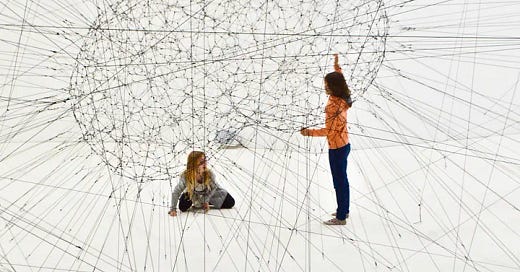It’s Betweenness That Matters, Not Your Eigenvalue: The Dark Matter Of Influence
The deep structure of being truly connected: being a conduit makes you a vector.
[Originally posted in 2010.]
Recent research suggests that the most important people in social networks, relative to actually transmitting ideas, viruses, or moods, might not be the folks with the most followers, but instead might be people that are connected to a large number of individuals through shorter paths than others have.
Emerging Technology from the arXiv, Best Connected Individuals Are Not the Most Influential Spreaders in Social Networks
The study of social networks has thrown up more than a few surprises over the years. It’s easy to imagine that because the links that form between various individuals in a society are not governed by any overarching rules, they must have a random structure. So the discovery in the 1980s that social networks are very different came as something of a surprise. In a social network, most nodes are not linked to each other but can easily be reached by a small number of steps. This is the so-called small worlds network.
Today, there’s another surprise in store for network connoisseurs courtesy of Maksim Kitsak at Boston University and various buddies. One of the important observations from these networks is that certain individuals are much better connected than others. These so-called hubs ought to play a correspondingly greater role in the way information and viruses spread through society.
In fact, no small effort has gone into identifying these individuals and exploiting them to either spread information more effectively or prevent them from spreading disease.
The importance of hubs may have been overstated, say Kitsak and pals. “In contrast to common belief, the most influential spreaders in a social network do not correspond to the best connected people or to the most central people,” they say.
At first glance this seems somewhat counter-intuitive but on reflection it makes perfect sense. Kitsak and co point out that there are various scenarios in which well connected hubs have little influence over the spread of information. “For example, if a hub exists at the end of a branch at the periphery of a network, it will have a minimal impact in the spreading process through the core of the network.”
By contrast, “a less connected person who is strategically placed in the core of the network will have a significant effect that leads to dissemination through a large fraction of the population.”
The question then is how to find these influential individuals. Kitsak and co say that the way to do this is to study a quantity called the network’s “k-shell decomposition”. That sounds complicated but it isn’t: a k-shell is simply a network pruned down to the nodes with more than k neighbours. Individuals in the highest k-shells are the most influential spreaders.
(via @karllong)
In network theory, these two cases are both example of centrality: ways of assigning values to individual nodes in a network based on how each node relates to the others.
The most connected people in a social network — those with the highest number of incoming and outgoing connections — have high eigenvalues. These eigenvalues can be calculated — like Google’s PageRank algorithm — by weighting the value of each connection based on the eigenvalue of the originator.
It’s not who you know, it’s where you know.
But this research suggests that a different way to measure the centrality might be more useful in determining how much throw weight a person actually has. Betweenness is a measure of how short are the chains that connects a person to the totality of the network. Like PageRank, betweenness is recursive: the people with the highest betweenness are likely to be connected to other people with high betweenness.
This means people are influential because they are connected to many influential people. But influence doesn’t seem directly linked to how many people you are connected to. It’s a function of being connected to others who have short chains to many other people with high betweenness. Or, looked at differently, betweenness is a measure of how many social circles, or social scenes, a person is connected to.
So, it’s not who you know, it’s where you know. It’s where you are situated in the network, and not just in the limited sense of how many immediate contacts you have.
The subtle, dark-matter mystery of social networks is that influence is oblique, and not easily determined by the sorts of tools we have today.
It is not your follower count, or who you follow, per se. But, instead, do you have short paths into other social scenes, both incoming and outgoing? That is the deep structure of being truly connected: bridging over different social scenes, acting as a conduit, a vector, a filter and amplifier for ideas good and bad, the best insights, and deadly viruses.
2016 update: A few years after writing this I stated
In a connected world the most important decision is who to follow.
That can be interpreted many ways, including the one sketched out above: that we are well-served by following those with high betweenness.



